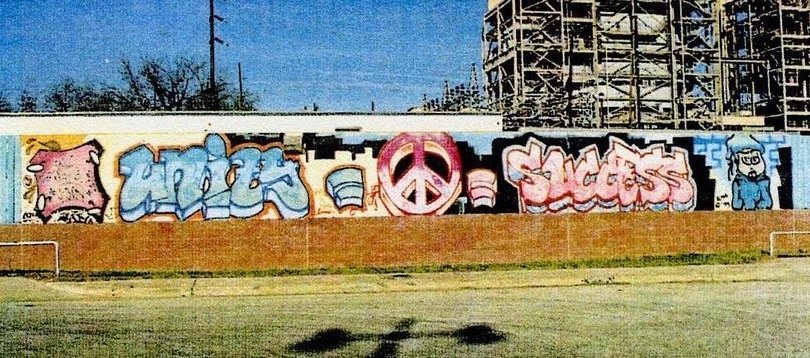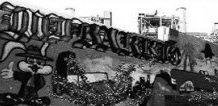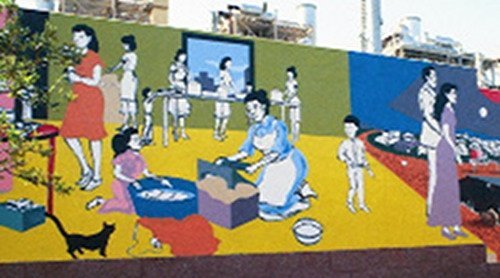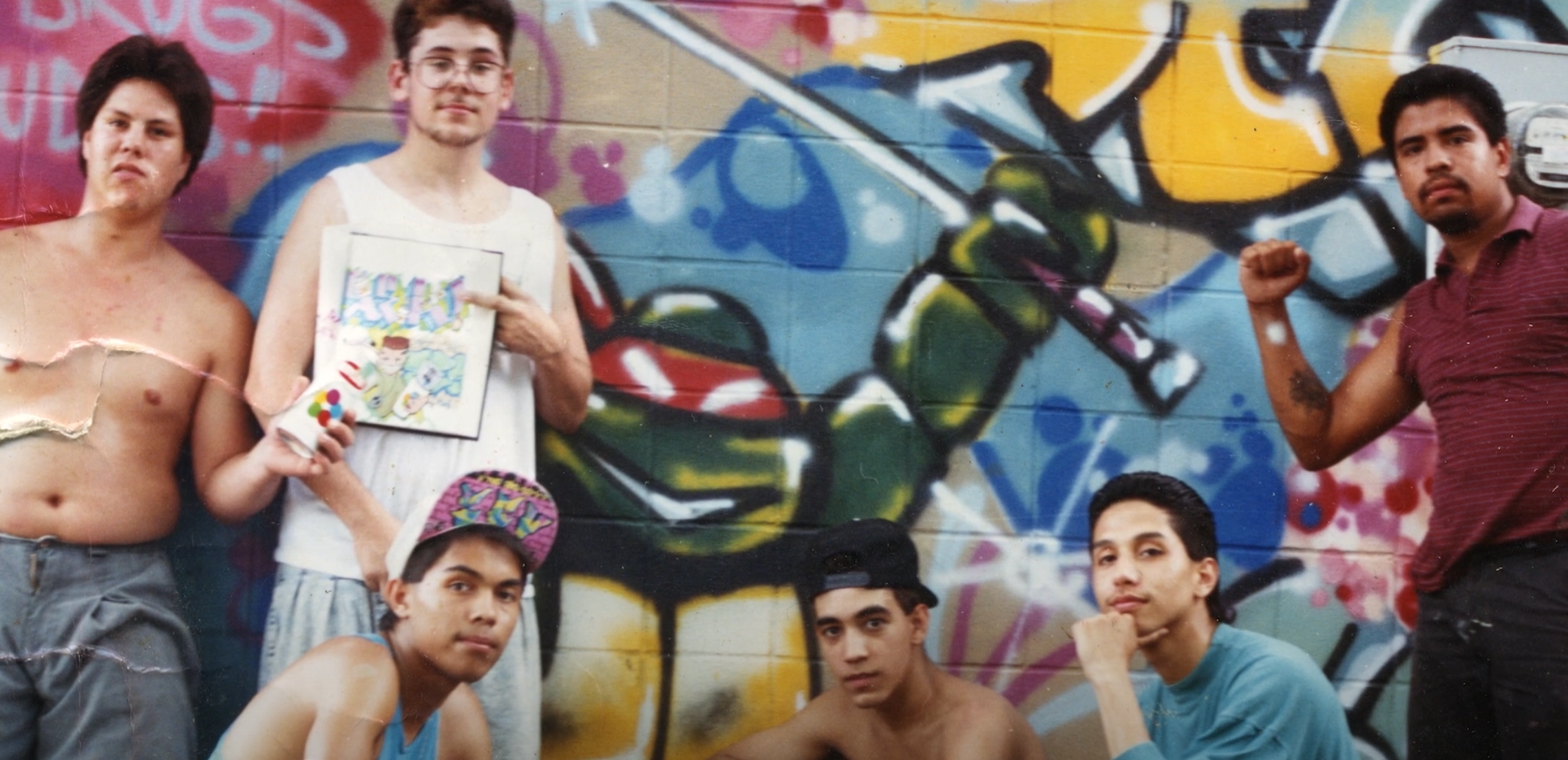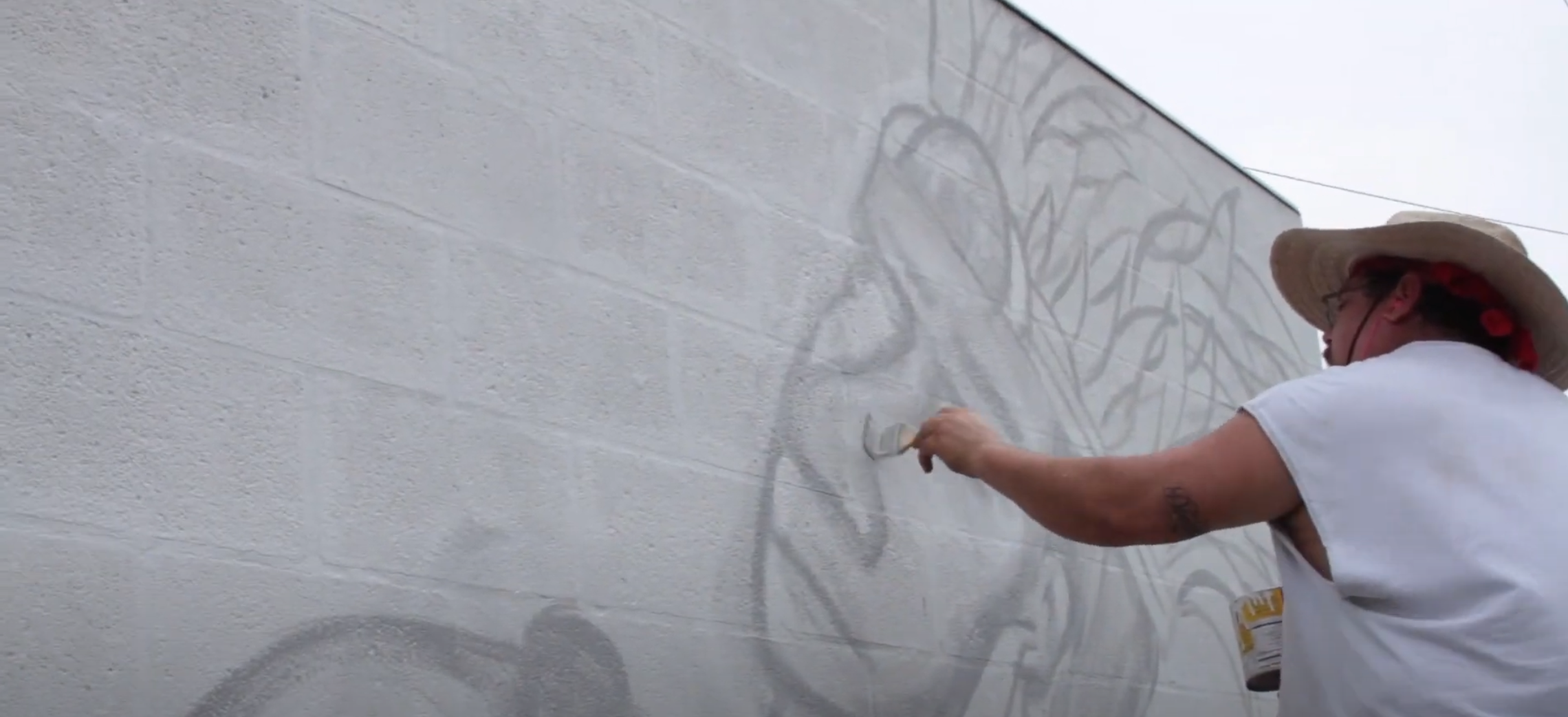
East Austin Barrio Landmarks: Holly Street Mural Guide
Prepared by Preservation Austin in Collaboration with Arte Texas
Project Context
In 1991, local artist Felipe Garza was selected to organize the painting of the newly erected sound wall around the Holly Street Power Plant with imagery that would celebrate the local heritage and make the invasive industrial site more visually bearable. The project began with approximately ten murals, though many artworks blend into one another along the walls, as they were first and foremost a collaborative project amongst graffiti artists and other members of the East Austin community. Garza invited over a dozen artists to take part in the artistic endeavor, as well as neighborhood youth who were encouraged to participate. Due to lack of funding and organizational troubles, many of the murals were never completed or were continuously worked on by artists over the years.
Graffiti is a raw, expressive art form that was booming across New York City in the 1980s. Skam, a graffiti artist from the New York-New Jersey area arrived in Austin that same decade, bringing the spirit of street art with him and inspiring many artists in East Austin to immerse themselves in the art form. Though Skam died at a young age just a few years after the Holly Murals were painted, his legacy as a dear friend and mentor lives on in the other muralists who painted alongside him and consider him a founder of graffiti in Austin. Several artists who participated in the painting of the Holly Street Murals, most of whom were in their twenties at the time, were active in promoting Chicano culture in the arts. Many of them were part of the League of United Chicano Artists (LUCHA), an organization that played an essential role in fostering the artistic community on the east side. Original artists include: Alfredo “Skam” Martinez, Ambray Gonzales, Arleen Polite, Armando “Taner” Martinez, Boomer, David Santos, Felipe “Flip” Garza, Fidencio Duran, J. Senco, Jean Aubrey, Joe Arellano, Joe Perez, Myko, Oscar “Tez” Cortez, Pete Guerro, Rab, Raymond “Rage” Mendoza, Robert “Kane” Herrera, and Steven Rendon.
Today, many of the murals remain on the sound walls and efforts are underway to preserve them. However, when the initial mural project took place, there was little consideration of creating long-lasting artworks, primarily due to a meager budget and the lack of accessibility to durable and weather proof paints and sealants. Since the walls were constructed for the primary purpose of noise abatement, they were built out of cinderblock: a cheap and porous material in which water was absorbed very readily, damaging the painted murals quite easily. The location of many of the murals also made them susceptible to intense sunlight, causing rapid deterioration of the artworks. Given all of these circumstances, most of the murals have faded to varying degrees and have been tagged with graffiti over the course of three decades. A number of murals have been restored or touched up by the original artists, some officially commissioned through Art in Public Places and others unofficially. Some murals have unfortunately been destroyed due to their contentious content, with portions of the wall now replaced with wooden planks. There is also a handful of new graffiti and tagging unrelated to the original murals, primarily on the western wall.
All of the murals around the Holly Street Power Plant are of utmost consequence and represent the strength and creativity of the Mexican American community that comprises an important portion of East Austin. Organizations like Arte Texas, founded by Bertha Delgado, and Art in Public Places (AIPP) are still underway to preserve and restore all of the murals that remain. Arte Texas is an organization dedicated to preserving and promoting public art in East Austin by Chicano, Mexican, Latino, and Indigenous peoples. Many of the original artists who painted the Holly Street Murals are part of Arte Texas, and they have led the way in working to assure that the artworks are archived, remembered, and preserved for years to come.
While the history of the power plant and the Holly neighborhood has been one of considerable struggle, these murals commemorate a community’s solidarity and their daily existence, capturing the joys and the spirit of Mexican American culture. The history of this site must not be forgotten. Born out of segregation and environmental racism, the Holly Street Power Plant has become a space where people dealt with social inequality to bring about positive change. It speaks not only to the injustices prevalent amongst the Mexican American neighborhoods in East Austin, but to Austin as a whole, and efforts to preserve and add to these murals has only just begun.
Mural Guide
For La Raza, Restored, Courtesy of Austin Art in Public Places
1. For La Raza
C. 1992, RESTORED 2018, ARTISTS INCLUDE ROBERT HERRERA, OSCAR CORTEZ, AND TANER MARTINEZ
The use of Chicano and ancient Aztec imagery in this mural was meant to inspire pride and unity during a time in the 1990s when gang violence was pervasive in the community.
Upon completion, the restored mural was awarded best restoration by the Austin Chronicle and a Preservation Merit Award from Preservation Austin in 2018. This restoration was a remarkable sign of progress in giving these murals the recognition they were so long overdue. As Herrera himself said, “Preserving this history is important to the neighborhood that it’s created in, as well as the city as a whole. (The murals provide) a picture of what the community has been through and where it is going.”
2.Untitled
C. 1991–1992, UNOFFICIALLY RESTORED (DATE UNKNOWN), ARTISTS INCLUDE TANER MARTINEZ, ROBERT HERRERA
This mural was unofficially restored by the original artists, with the central figure repainted and the words “Arte Texas” added above to graffiti that reads “Life” and “Art”.
Photo by Oliver P. Franklin, Listen to the Walls Speak: Murals and Symbology in Austin Texas, 1990–1995
3.Sign of the Times
C. 1993, ARTISTS INCLUDE TANER MARTINEZ AND STEVEN RENDON
Located along the south wall of the Power Plant, this mural originally included the words “Unity” and “Success,” reflecting a spirit of optimism embodied by the mural project.
Though substantially faded, much of the original composition remains discernible. The artist’s signature and the date can still be seen at the bottom of the mural, and the wooden planks on either side used to consist of walls that were also painted.
4.Big Arch
C. 1991–1992, ARTISTS INCLUDE JOE PEREZ AND DAVID SANTOS
Designed by stone artists Joe Perez and David Santos, the building of Big Arch was meant to teach neighborhood youth the craft of stone carving.
The carved limestone and forged iron structure has imprints of shells embedded across its surface and at the top of the archway facing Riverview Street one can see a beautiful carving that includes faces of figures from ancient times to the present, an Aztec pyramid, and LUCHA’s symbol of the eagle carved into the left of the composition. On the other side of the arch in the center is a small tile with images of cacti, the eagle, and the state of Texas. Cacti can also be seen sitting atop the sculpture. For the artists, it was important to include the cactus as they felt it was representative of Mexican flora. The other two archways on either side of Holly Street along the hike and bike trail are also part of the overall Holly Street mural project. Looking closely, one can see painted tiles at the top central part of both arches.
Untitled, Pre-restoration, Courtesy of Austin Art in Public Places
5.Untitled
C. 1991–1992, UNOFFICIALLY RESTORED IN 2019, ARTISTS INCLUDE DAVID SANTOS
This original version of this mural had the name of Joe Perez alongside a large male figure against the backdrop of a natural scene.
In 2019, Santos decided to add five distinct names and faces to the mural: Raúl Salinas, Akwasi Evans, Cecilia Bustamante, Marsha Gómez, and Joe Perez. Salinas was a Chicano poet and activist who worked to make prisoners’ rights a central part of the Chicano movement and ran Resistencia Bookstore, home of Red Salmon Arts. Evans was a prominent African-American journalist and civil rights activist who launched NOKOA, a community newspaper highlighting progressive political action in Central Texas. Bustamante was a prolific Peruvian poet, journalist, editor, and translator, and was the first woman to be awarded the National Prize for Poetry in Peru in 1965. Gómez was a sculptor of Choctaw and Chicana descent who worked with traditions of indigenous pottery, and became the founding director of Alma de Mujer Center for Social Change in 1988, a retreat center in Austin supporting queer women and women of color, which still functions today. Perez was a fellow artist who worked with Santos on several limestone sculptures around the city. Placed all together, Santos pays homage to his leaders who have passed, all of whom were extraordinary educators in the community.
6. Progress of Civilization
C. 1991–1992, UNOFFICIALLY RESTORED (DATE UNKNOWN), ARTISTS INCLUDE AMBRAY GONZALES
This humanitarian mural includes a melange of people and animals against Austin’s cityscape in the central panel, fading into nature on either side.
Gonzales is a humanitarian and one of the original members of ALMA. On the bottom right hand side appears a woman holding a fabric that says, “Respecta a los derechos humanos” or “respect human rights” followed by a phrase that has now become illegible but includes the final phrase “y todo el mundo”, meaning “and the whole world”.
7. Untitled
C. 1991–1992, ARTISTS UNKNOWN
This panel includes the names of several artists who participated in the mural project organized by Felipe Garza.
Original photo of The Children are the Future, courtesy of Austin Art in Public Places
8.The Children are the Future
C. 1991–1992, ARTISTS INCLUDE SKAM, ROBERT HERRERA, TANER MARTINEZ, RAYMOND MENDOZA, RAB, BOOMER, J. SENCO
This mural spans the remaining length of the western wall to the archway facing Holly Street. The latter half of the mural, “Children at War” is still visible on the leftmost side of the wall.
The Children are the Future was designed and painted by Skam, who is considered to have brought graffiti to Austin in the early 1980s. He was an educator and mentor to many, including the other artists who painted this mural.
Original photo of Untitled, Courtesy of Austin Art in Public Places
9.Untitled
C. 1991–1992, ARTISTS INCLUDE ARLEEN POLITE
Arleen Polite was a prolific artist, educator, activist, and healer.
As an African American artist from Florida born in the early 1960s, she experienced the integration of schools and the pervasive racism that continued following the civil rights movement. She was a strong ally of the Chicano community, whose social justice struggles and efforts were closely aligned with the African American community in Austin. She was most widely known for her woodcuts, but also made many drawings, paintings, and murals.
Original Photos of Me Barrio, Courtesy of Austin Art in Public Places
10. Me Barrio
C. 1991–1992, ARTISTS INCLUDE TANER MARTINEZ
This mural, once spanning across a large portion of the northern wall, is now broken up into three parts that still remain visible.
The first part closest to Polite’s murals depicts cholos and lowriders, which are iconic aspects of Chicano subculture. By the defunct railroad track, two parts of Me Barrio remain with a cargo entrance to the power plant now dividing them. On the right of the gate one can still make out the faint word “GRAFFITI” and on the left of the gate there is imagery of the Virgin Mary and an Aztec woman warrior.
La Quinceañera, Pre-restoration, Courtesy of Austin Art in Public Places
11. La Quinceañera
C. 1991–1992, RESTORED 2003, ARTISTS INCLUDE FIDENCIO DURAN
This mural depicts an entire day in preparation and in celebration of a young woman’s fifteenth birthday, a quinceañera. Quinceañeras are an important part of Mexican and other Latin American cultures, and represent a girl’s passage into womanhood. They are religious and social events that signify a woman’s coming of age.
For Duran, the event encompasses all aspects of this important day in Mexican tradition and was culturally relevant to the residents of the Holly neighborhood. Duran’s artistic mission is to honor and uplift the culture of his family and community. For the mural, he originally used oil-based paints on a surface that was not properly primed, which meant it had significantly deteriorated by 1998. In 2003, he worked with the Austin Energy department to refurbish his artwork along with assistants whose names are signed alongside Duran’s, using exterior water-based latex paints, painting many layers, and sealing it with an acrylic varnish so that it could withstand outdoor conditions.
12. Untitled
C. 1991-1992, VARIOUS ARTISTS
This wall was known as the fun wall or the tagging wall, where all of the artists and children were invited to tag and paint whatever they wanted.
This wall epitomizes the collaborative and generative nature of the initial project to paint the sound walls around a space that had been detrimental to the neighborhood for so many years. The graffiti on this wall extends all the way to the electric tower, and reminds us of the unwavering community resistance and solidarity channeled through art and creativity.
See the “Public Art Action Plan for the Holly Shores Master Plan Area” report prepared in 2013 by the City of Austin, Art in Public Places, and Go Collaborative for more information on plan’s for the site and an inventory of mural photos from 2011.
Acknowledgments
Text prepared by Catalina Cherñavvsky Sequeira.
Special thank you to Bertha Rendon Delgado, Robert Herrera, Fidencio Duran, Raymond Mendoza, Taner Martinez, the artists of Arte Texas, and Austin Art in Public Places.
This research was made possible thanks to the generosity of the Fowler Family Foundation.
Associated Videos
AUSTIN GRAFFITI PROJECT
Graffiti artists remember Skam’s legacy and the importance of graffiti in Austin, featuring Armando Martinez, Felipe Garza, Raymond Mendoza, and Robert Herrera
LA PRENSA REMEMBERS SKAM AL MARTINEZ
Features several Holly Street Muralists speaking of Skam’s Legacy (including Robert Herrera, Armando Martinez, Oscar Cortez, Bertha Delgado, and Skam’s mother and sister)
CITYVIEW: FOR LA RAZA
FOR LA RAZA MURAL
The making of the restored mural.
BERTHA
The making of the restored mural (continued).
ARTE TEXAS MURAL PROJECT UPDATES
The making of the restored mural (continued).
HOLLY POWER PLANT GROUNDBREAKING 2021
Other Programs
-

Homes Tour
-

Grants
-

Additional Self Guided Tours



